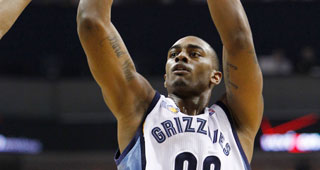While there are only a small handful of players capable of changing the balance of power in the NBA, a close playoff series can be swung by what one rotation player does (or does not) give a team in a four-or-five minute stretch. Neither the Oklahoma City Thunder or the Memphis Grizzlies have had the flexibility to make any major moves this offseason, but both should be significantly improved by a talented young role player coming off a year-long injury.
Darrell Arthur, the No. 27 pick in the 2008 draft, and Eric Maynor, the No. 21 pick in 2009, will never be stars. However, their absence due to season-ending knee injuries was sorely felt by their respective teams last season.
Arthur, a McDonald’s All-American who won a national title with Kansas in 2008, fell in the draft due to concerns about his kidneys. An athletic 6’9, 235 forward with a 6’11 wingspan, his versatility on both ends of the floor played a huge role in the Grizzlies upset of the San Antonio Spurs in 2010. The Spurs had no answer for the size of Marc Gasol and Zach Randolph, but Memphis still needed a third big man to give them 15+ minutes a game.
With the athleticism to play above the rim and the quickness to switch on the perimeter, he is the perfect defensive complement to the more floor-bound duo of Gasol and Randolph. The Grizzlies don’t frequently run offense through him, but he’s an excellent off-ball big man, capable of stepping out for a 15-20 foot jumper (an 81% foul shooter in 2010) as well as catching and finishing at the rim (shooting 66% from the paint in 2010).
Without Arthur in the 2012 playoffs, Memphis coach Lionel Hollins had to mix and match frontcourt reserves. It came to a head in Game 7 of their first-round series against the LA Clippers, when Hamed Haddadi and Dante Cunningham, two marginal NBA big men, played seven crucial minutes in the second half. The Grizzlies were -9 in those minutes; they lost the game 82-72.
The Thunder, meanwhile, lost the NBA Finals in a series far closer series than the five-game total suggests. The turning point came when the Miami Heat inserted Chris Bosh into the starting lineup in Game 2, but Oklahoma City should be haunted by their 91-85 loss in Game 3, particularly the 15-3 run Miami went on at the end of the third quarter when Kevin Durant and Russell Westbrook were off the floor.
James Harden was their only offensive threat in the game, which allowed the Heat to turn the screws defensively and give themselves a comfortable margin for error headed into the fourth quarter. It’s hard to say one game would have been the difference in a series that went 4-1, but a Game 3 win would at least have ensured the series went back to Chesapeake Arena, one of the toughest places to play in the NBA.
The Thunder found another level last year when they played Durant at the power forward position, opening up the floor and becoming practically indefensible. However, they were still playing large stretches with one hand tied behind their back, as they only had two consistent threats (Harden and Westbrook) for three spots on the perimeter.
Derek Fisher, by virtue of his “veteran leadership” and “championship experience”, picked up most of the minutes created by Maynor’s season-ending knee injury. Unfortunately, at the age of 37, his best days had long since passed him by, and he gave the Thunder exceedingly little. Unable to move his feet defensively or create offense off the dribble, he was relegated to being a 6’1 spot-up shooter, not a lot of value for a player who averaged over 20 minutes per game in the postseason.
Fisher was on the floor during that pivotal Game 3 stretch when Oklahoma City’s offense imploded. Throughout the series, his lack of offensive ability gave Erik Spoelstra a place to hide some of his weaker defenders (Mike Miller, James Jones, Mario Chalmers). In Game 4, he played 22 minutes without a single point, rebound or assist.
Maynor can shoot three-pointers (career 35% from deep) as well as Fisher while bringing a lot more to the table. A crafty 6’3, 175 point guard with a below-average 6’2 wingspan, he’s the rare young player with an excellent mid-range game, which he used to put himself on the map in VCU’s 2007 NCAA Tournament upset of Duke.
He doesn’t have the athleticism to be an elite defender or consistently finish in the lane (a career 41% shooter from the floor), but he’s one of the best back-up point guards in the NBA. As his career 3.1 assist to 1.0 turnover ratio attests, he doesn’t make many mistakes on the floor and he’s more than capable of running Oklahoma City’s offense when Westbrook is on the bench.
The Grizzlies recently re-signed Arthur to a shrewd three-year $9 million contract, while Maynor is still on his rookie deal. They’re excellent examples of the value of cost-controlled young players teams can find late in the first round, especially with the new stringent luxury tax penalties making veterans on mid-level contracts more cost-prohibitive.
The duo wouldn’t move the needle much if they played for Charlotte, but they’re solid NBA contributors who wouldn’t be overmatched in the fourth quarter of a Game 7. Regardless of the situation, they won’t hurt their teams when they’re on the floor, which is more than can be said for the players who replaced them in last year’s post-season.

Jonathan Tjarks wrote on the NBA for RealGM from 2011-2016 before joining The Ringer.
Follow @JonathanTjarks on Twitter.


